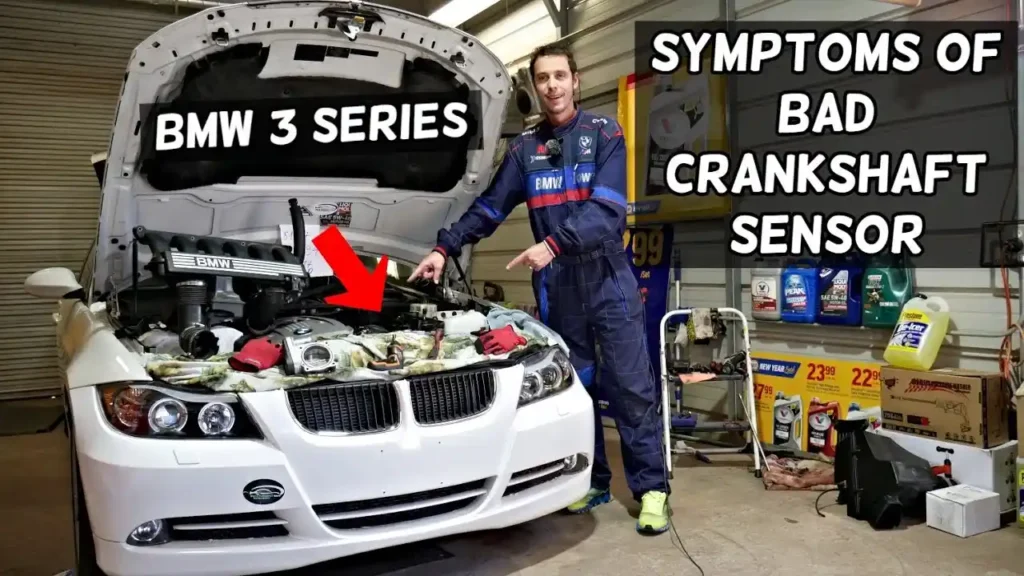If you’re driving a BMW and suddenly notice strange engine behavior or your vehicle starts to act up, it could be a sign that your crankshaft position sensor is failing. This small yet vital component plays a crucial role in the engine’s performance. In this guide, we’ll walk you through the BMW Crankshaft Position Sensor Symptoms, why it fails, and how to fix it.
What is a Crankshaft Position Sensor and Why is it Important in BMW Vehicles?
The crankshaft position sensor is a critical component in your vehicle’s engine management system. It monitors the position and rotational speed of the crankshaft, the part that controls the pistons in the engine. This data is essential for the Engine Control Unit (ECU) to control the timing of ignition and fuel injection.
In BMWs, this sensor helps maintain the precise engine performance that the brand is known for. It ensures your engine is running smoothly, efficiently, and with optimal fuel consumption. Without it, you could experience a range of performance issues, from poor fuel economy to complete engine failure.

Top BMW Crankshaft Position Sensor Symptoms to Watch Out For
1. Check Engine Light
One of the first signs that your crankshaft position sensor might be failing is the appearance of the check engine light on your dashboard. This light turns on when the ECU detects issues with the sensor, often due to faulty or inconsistent readings.
When you see the check engine light, it’s time to get your car diagnosed by a mechanic. Diagnostic Trouble Codes (DTCs) will indicate a problem with the crankshaft position sensor, and an expert will be able to confirm the issue.
2. Difficulty Starting the Engine
A bad crankshaft position sensor can lead to starting issues. When the sensor is malfunctioning, the engine may crank for a long time before starting, or it may not start at all. This happens because the sensor’s role in ignition timing is crucial for proper engine start-up.
If you’re having trouble starting your BMW, this could be a sign of a sensor failure.
3. Engine Stalling or Hesitation
Stalling, especially when coming to a stop, or hesitation when accelerating are common symptoms of a bad crankshaft position sensor. The sensor controls the fuel injection and ignition timing. If it fails, the ECU cannot adjust the timing accurately, causing the engine to stall or hesitate.
You may notice these issues particularly when your vehicle is idling or at low speeds.
4. Rough Idling or Misfires
Another symptom is rough idling or misfires. A malfunctioning crankshaft position sensor can lead to incorrect fuel injection timing. This results in uneven combustion, causing your engine to run roughly, especially at idle.
If your BMW is misfiring or vibrating during acceleration, the sensor may be at fault.
5. Poor Acceleration
A faulty crankshaft position sensor affects your engine’s power output, leading to sluggish acceleration. If you notice that your car isn’t responding as quickly as usual or feels underpowered, the sensor could be failing. This happens because the sensor is responsible for coordinating the fuel injection and ignition timing, both of which are vital for smooth acceleration.
6. Decreased Fuel Economy
If your BMW’s fuel efficiency suddenly drops, it could be due to a bad crankshaft position sensor. The sensor helps the engine maintain the correct air-fuel mixture. If it’s malfunctioning, the mixture may become too rich or too lean, resulting in poor fuel combustion and lower gas mileage.
7. Vibrations in the Engine
In some cases, a bad crankshaft position sensor can cause vibrations in the engine. This happens because incorrect ignition timing leads to uneven combustion. You might feel vibrations or hear unusual sounds as the engine tries to maintain balance.
8. Engine Overheating
A less common but possible symptom of a faulty crankshaft position sensor is engine overheating. Since the sensor also plays a role in regulating the engine’s timing, a malfunction can cause the engine to overheat as it struggles to perform correctly.
Causes of Crankshaft Position Sensor Failure in BMWs
Understanding why the crankshaft position sensor fails can help prevent future issues and allow you to address them before they become a bigger problem.
1. Wear and Tear Over Time
Like most engine components, the crankshaft position sensor deteriorates over time. It’s exposed to extreme conditions like heat, vibrations, and contaminants, all of which can wear it out. Prolonged exposure to these harsh conditions reduces the sensor’s functionality, causing inaccurate readings.
2. Damaged Wiring and Connection Issues
Sometimes, the issue isn’t the sensor itself but the wiring connecting it to the Engine Control Unit (ECU). Worn or frayed wires, corrosion, or poor connections can disrupt the sensor’s signals, leading to inaccurate readings and engine problems.
3. Dirt and Debris Build-up
The crankshaft position sensor is located near the engine, so it’s vulnerable to dirt, oil, and debris buildup. Over time, these contaminants can interfere with the sensor’s ability to accurately monitor the crankshaft’s position. Keeping the area around the sensor clean can help prevent this issue.
4. Weakening of the Magnetic Field
Crankshaft position sensors rely on magnetic fields to detect the rotation of the crankshaft. Over time, the magnetic field can weaken, causing the sensor to lose its accuracy. A weakened magnetic field results in incorrect readings and engine performance issues.
How to Fix a Faulty Crankshaft Position Sensor in Your BMW
1. Sensor Replacement
If your crankshaft position sensor is faulty, replacing it is the most effective solution. While the part itself is usually affordable, the labor costs to replace it can vary depending on the model of your BMW and the complexity of the repair.
If you’re a DIYer, you may be able to replace the sensor yourself. However, it’s important to have the right tools and expertise, as improper installation can lead to further engine problems.
2. Cleaning the Sensor
In some cases, a simple cleaning can resolve issues. If dirt or debris is causing the sensor to malfunction, carefully cleaning it might restore its functionality. Use a cleaning solution designed for automotive sensors and make sure to follow the manufacturer’s guidelines.
3. Inspecting and Replacing Wires
If the wiring is damaged, it can lead to poor performance and intermittent sensor failure. Inspect the wiring for any signs of wear, corrosion, or disconnection. If you find any issues, you may need to replace the damaged wires or connectors to ensure proper communication between the sensor and the ECU.
4. When to Seek Professional Help
If you’re unable to fix the issue on your own or if the sensor failure is more complex, it’s best to consult a professional mechanic. A trained technician will have the tools and expertise to diagnose and fix the issue efficiently.
Common FAQs About BMW Crankshaft Position Sensor Symptoms
1. Can a bad crankshaft position sensor cause my BMW to stall at low speeds?
Yes, a faulty crankshaft position sensor can lead to engine stalling, especially at low speeds or when coming to a stop. This is due to incorrect fuel injection and ignition timing caused by the sensor’s failure.
2. How much does it cost to replace a crankshaft position sensor in a BMW?
The cost of replacing a crankshaft position sensor in a BMW typically ranges between $200 and $600, including parts and labor. The exact price will depend on your model and the repair shop you visit.
3. How can I tell if my crankshaft position sensor is failing without a check engine light?
If you notice poor acceleration, rough idling, stalling, or a decrease in fuel economy, it may indicate a failing crankshaft position sensor, even if the check engine light hasn’t turned on.
4. How do I reset my BMW’s ECU after replacing the crankshaft position sensor?
After replacing the crankshaft position sensor, you can reset your BMW’s ECU by disconnecting the battery for 10-15 minutes. Alternatively, a professional mechanic can reset the ECU using a diagnostic tool.
Final thoughts: BMW Crankshaft Position Sensor Symptoms
The crankshaft position sensor is a small yet vital part of your BMW’s engine. Its failure can lead to a host of performance issues, from stalling and rough idling to decreased fuel economy. Recognizing the symptoms early on and addressing the problem promptly can save you from costly repairs down the road.
Regular maintenance, including cleaning the sensor and inspecting the wiring, can help extend the lifespan of this crucial component. If you suspect a malfunction, don’t hesitate to seek professional help to keep your BMW running smoothly and efficiently.
